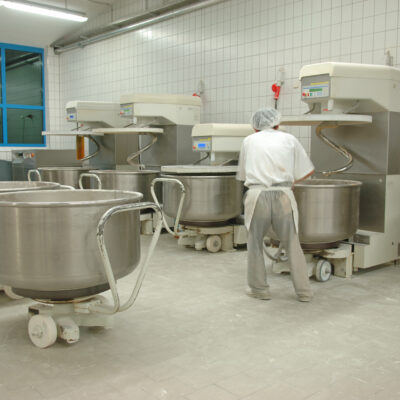
A major pet food products manufacturer recently engaged Process and Data Automation (PDA) to help them rapidly transform warehouse space into a self-contained pet treats manufacturing operation. Their R&D department created a potentially game-changing individual treat product so the manufacturing branch would have to deliver a large-scale solution in very short order. Thankfully ample space existed within a viable manufacturing plant in terms of their expansive warehouse space, a location that could be quickly converted into a product kitchen and packaging area. Perhaps as important, a relationship existed with a turnkey systems integrator in PDA who could take the design to a finished solution quickly and accurately.
PDA drew from their vast experience in batch operations and controls to craft and deploy a system to support this operation. While this process was small compared to many that PDA works on, it was somewhat complex in the number of unique facets that it brought together in the final solution. Based on client specifications and the need for a safety system interface, PDA designed a Rockwell Automation GuardLogix solution. This controller handled all the local I/O, safety inputs, and network interfaces, and connected to the plant’s existing GE iFix infrastructure.
As is typical in batch operations, product ingredients were assembled in a batch or mix tank and later transferred to a working or “day tank” that keeps the treat depositor equipment fed. This architecture ensures that the product depositor is fed continually while an additional batch can be made and prepared to serve next. Various ingredients like tallow are added to the heated batch tank via either precision metering or gain-in-weight addition as controlled by the mix tank’s Hardy weigh solutions cells and controller. Additional products like digester, cottonseed flake, and yeast were batched in using a separate loss-in-weight super sack system with chain conveyor, via a dedicated pre-batch tank on its own load cells, and via a separate, manual hand-add stand station. Many of the input products batch simultaneously based on their individual meters and scales with the batch tank providing a master confirmation based on its own load cells. Manually weighed hand-adds occur separately as directed by the system Human Machine Interface (HMI) and then transfer in upon prompt to the operator. The system scales verify that the manual adds have vacated from the hand-add scale and been added to the product mix tank, all of which are validated against a master recipe and tolerances.
The Hardy weighing systems connect to the system PLC via an I/O Ethernet I/P interface. This Ethernet interface also connects the system’s flow meters and variable frequency drives (VFDs). Direct I/O connections handled the various temperature, flow valves, and other points. The system safety interface was directed to the safety controller while a Prosoft Technology BACnet interface was used to incorporate the new room’s HVAC and chiller controllers into the overall monitoring system.
The plant’s existing iFix system provided the recipe interface between the corporate information system and the treat controller’s native Ethernet port. This information was passed to and used by the PLC and HMI. On the opposite side, the PLC collected information about batch ID, ingredient lots, and consumption quantities which were reported back to the information system via tables in the iFix database.
Since the system was being deployed inside a building within a building for hygiene reasons, the process control system became the ideal place to monitor ancillary systems. The HVAC system interface verifies that the necessary positive pressure is maintained within the production room and the chiller interface provides the status of that system’s health. All this information is provided back to the central database for verification purposes.
PDA provided detailed designs for the installation contractors. Following installation, the PDA team conducted a wiring inspection and general system I/O checks. Once the installation was verified and the field equipment checked, the team commissioned the automated portions. This involved validation of the batch system connections, batch operations, and data collection. The plant’s safety system checks were also executed to confirm that operators were safe to their strict requirements when working around the new machinery. All the system functions operated as expected.
The client began operation as planned and has delivered the treat products per specification. When asked for feedback on PDA, the client’s corporate project manager stated: “I have nothing but positive feedback from working with PDA. The communication and responsiveness were crucial in executing this project and PDA was a great partner to work with”. The batch system, while small, supplies both the existing packaging line and provides a platform on which to add a second line if that is later required. This can be accomplished simply with little modification to the overall control system thanks to the team at PDA.
Posted In: Application Stories, News
© 2025 Process and Data Automation, All Rights Reserved.